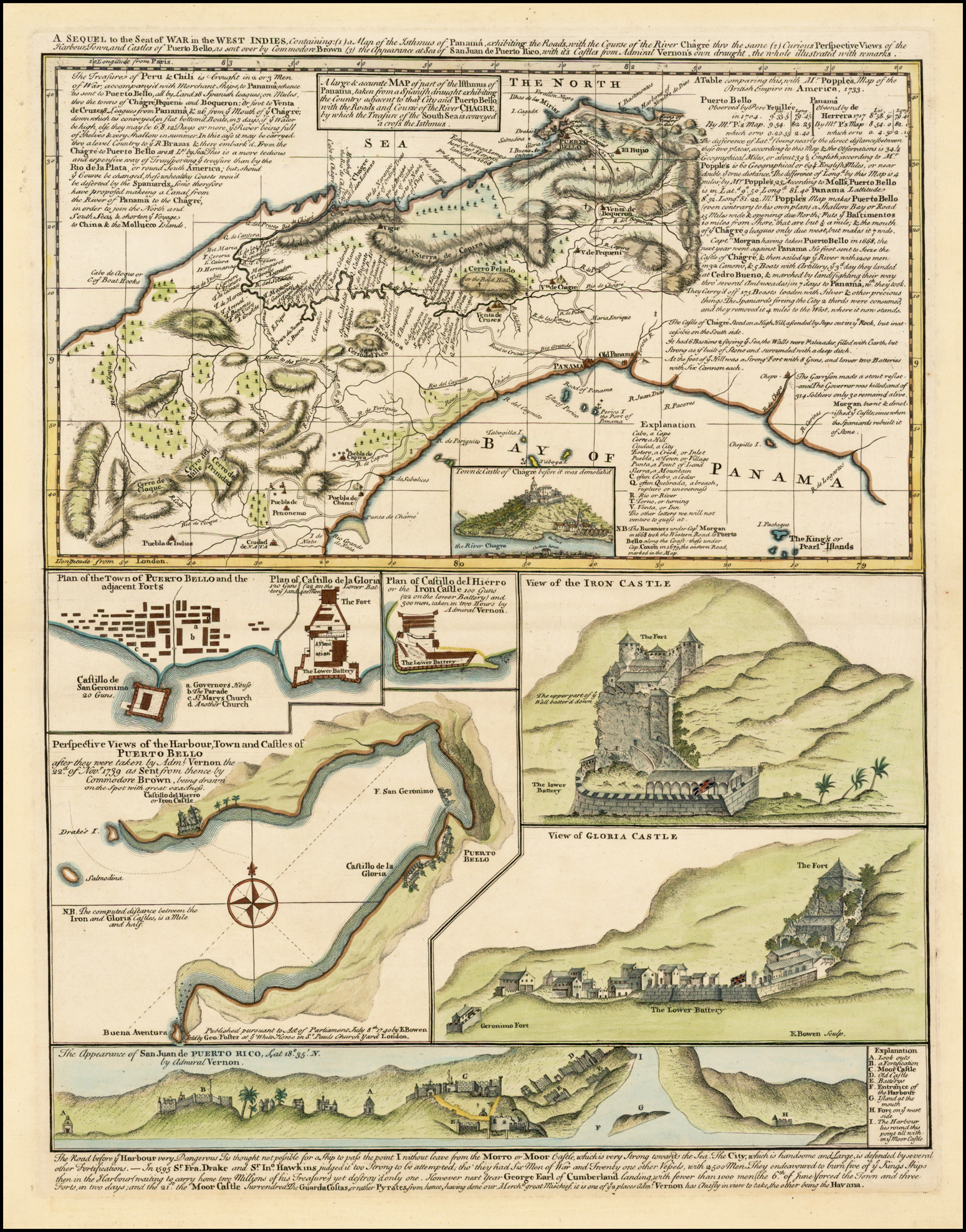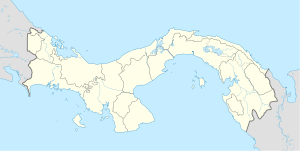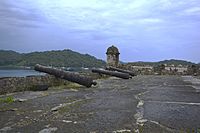Fortifications on the Caribbean Side of Panama: Portobelo-San Lorenzo facts for kids
Quick facts for kids Fortifications on the Caribbean Side of Panama: Portobelo-San Lorenzo |
|
|---|---|
| Fortificaciones de la costa caribe de Panamá | |
| Portobelo and Fort San Lorenzo, Panama | |

The ruins of fort San Lorenzo at Portobelo.
|
|
| Coordinates | 9°33′18″N 79°39′18″W / 9.555°N 79.655°W |
| Site history | |
| Built | 17th and 18th century |
| Built by | Spanish Empire |
| Official name: Fortifications on the Caribbean Side of Panama: Portobelo-San Lorenzo | |
| Type: | Cultural |
| Criteria: | (i) (iv) |
| Designated: | 1980 (4th session) |
| Reference #: | 135 |
| Region: | Latin America and the Caribbean |
The Fortifications on the Caribbean Side of Panama: Portobelo-San Lorenzo are old military buildings. They were built by the Spanish Empire in the 1600s and 1700s. These forts are located on the Caribbean coast of Panama.
These amazing ruins are found in the Colón Province. Because they are so important, UNESCO named them a World Heritage Site in 1980. They are seen as "magnificent examples" of military architecture from that time. The forts helped protect important trade routes across the Atlantic Ocean.
Contents
Where are the Panama Forts Located?
The Portobelo and San Lorenzo forts are about 80 kilometers (50 miles) apart. They are both on Panama's Atlantic coast. The forts at Portobelo protected the Panama harbor on the Caribbean side. The San Lorenzo forts guarded the mouth of the Chagres River.
Portobelo was built as another port on the Caribbean. It was an alternative to Nombre de Dios. This new port helped ships travel through the Isthmus of Panama. It was especially useful to avoid land routes during the rainy season. The Chagres River route combined water and land travel. It was another way to reach Portobelo, besides the Camino Real road.
Why Were the Forts Built?
In 1502, Christopher Columbus landed in a village in Panama during a big storm. Legend says he named it Puerto Bello, meaning "Beautiful Port." Later, in 1586, Bautista Antonelli drew up plans for the first forts. These forts would protect the entrance to Portobelo Bay and the Chagres River. They were built by the 1590s.
The town of San Felipe de Portobelo officially started on March 20, 1597. Over time, Portobelo became a very important Spanish base in the New World. It was connected by a stone road to Panama City. The port was a key place for moving goods. Spanish explorers would temporarily store gold and silver there. This treasure came from the Incan mines. Donkeys carried the treasure from the Pacific side of Panama to Portobelo on the Caribbean side. From there, it was shipped to the King of Spain.
History of the Fortifications
As Portobelo grew, more forts were built to protect it. This happened from 1600 until 1753. In total, 10 different forts were built on the hills behind Portobelo port. This made it the "most heavily fortified Spanish coastal control point in the Americas."
Many forts were attacked and destroyed. Only the forts built in 1753 are still in good condition. Admiral Vernon did not attack Portobelo during the last battle. Earlier, Sir Francis Drake tried to attack the fort but got sick and died. He was buried in the bay. In 1596, he had burned Nombre De Dios. His lead coffin in the sea has his name on it.
After Drake's attack in 1597, Spain decided to make Portobelo stronger. The treasury was moved there. Fort San Felipe was built first at the harbor entrance. It had 35 cannons. Fort San Jeronimo was built on the east side, and Fort Santiago de la Gloria on the west. These forts were made with strong coral stone walls.
In 1668, the Welsh pirate Sir Henry Morgan attacked Portobelo. His men used wide ladders to climb the fort walls. The pirates stayed in the city for a month. But the forts themselves were not badly damaged. In 1688, English pirate Bartholomew Sharp and French buccaneer La Sound also attacked the forts. They caused some damage. Later attacks in 1744 spared the forts, but the customs house was badly damaged.
For over 200 years after 1753, the forts were neglected. Plants grew all over them. Then, the Government of Panama decided to restore them. After Panama became independent, Spain left the San Lorenzo Fort in 1821. When Panama joined Colombia, the fort was used as a prison. Later, it became a post office for mail from Britain to Latin America.
The town of Chagres, near the fort, was a popular spot for adventurers. This was during the California Gold Rush in 1849. But when the railroad was built in 1850, the Chagres River route became less important.
In July 2012, UNESCO added Portobelo and Fort San Lorenzo to the List of World Heritage in Danger. This was due to environmental problems, poor upkeep, and uncontrolled building. UNESCO had first listed the site as cultural heritage in 1989.
Panama's laws protect these forts. Law 14/1982 (updated by Law 58/2003) covers heritage sites. Law 32/2003 protects historical structures found underwater.
How the Forts Were Designed
The forts in Portobelo Bay show European military architecture. They were built during the colonial period (1596–99). The earliest buildings were in a medieval style. But in the 1700s, the forts were updated with new designs. You can see these changes at Santiago Fort, San Jeronimo Fort, and San Fernando Fort. The San Lorenzo Fort also shows these changes.
The custom-house, which was damaged in 1744, has been rebuilt. It is now used as a museum. Many of the old cannons were damaged to stop them from being used again. Their wooden parts have rotted away. However, the forts themselves are still in good condition.
The San Fernando fortifications include:
- Lower Battery, Upper Battery, and Hilltop Stronghold
- San Jerónimo Battery Fort
The Santiago fortifications include:
- Castle of Santiago de la Gloria ("Gloria Castle"), Battery, and Hilltop Stronghold
- Old Santiago Fortress
- Ruins of the
 (Iron Castle)
(Iron Castle) - La Trinchera site
- Buenaventura Battery
- San Cristóbal site
The Chagres River site includes:
- San Lorenzo Castle (originally "San Lorenzo el Real del Charge")
- Upper Battery
Gallery
See also
 In Spanish: Fortificaciones de la costa Caribe de Panamá para niños
In Spanish: Fortificaciones de la costa Caribe de Panamá para niños










